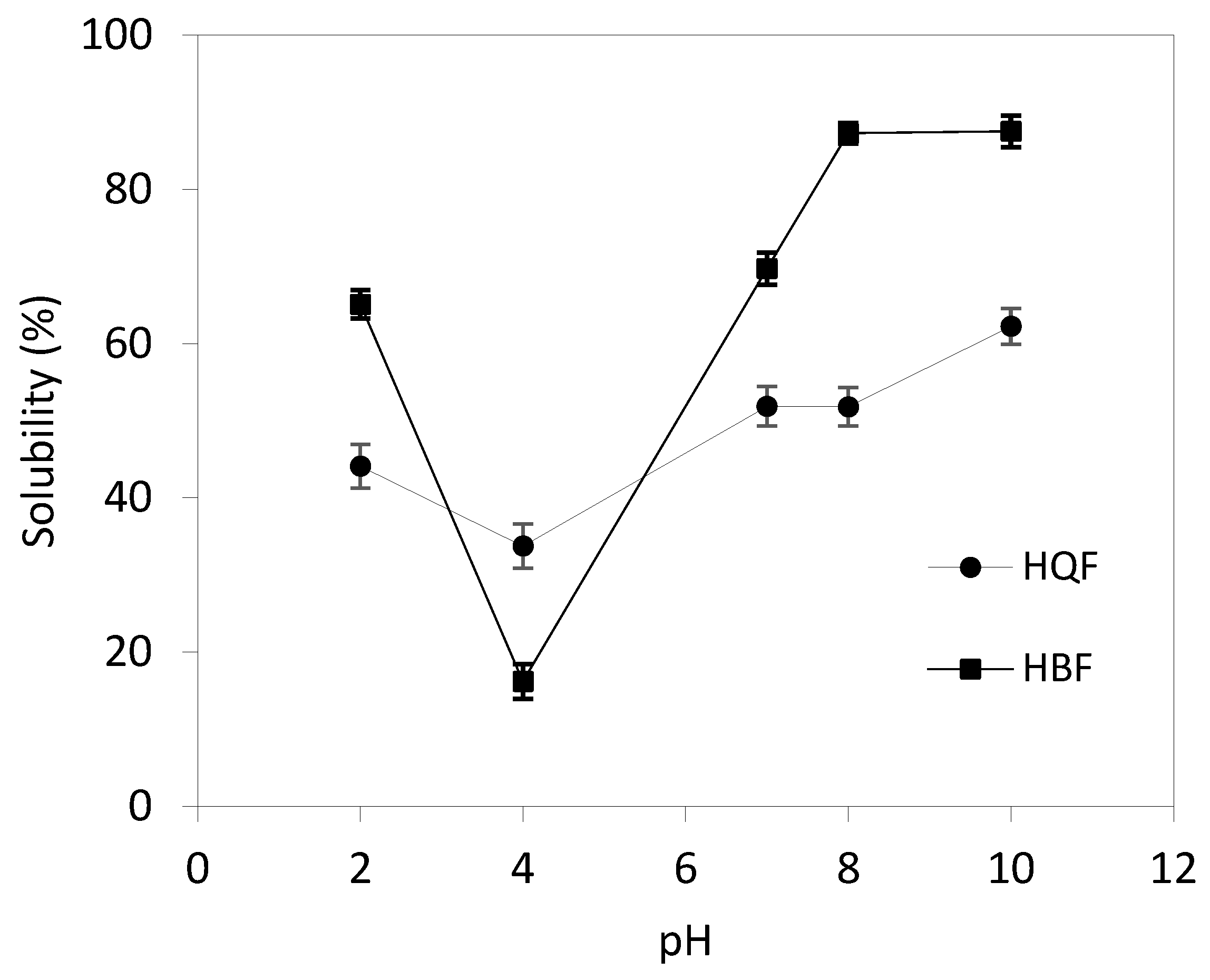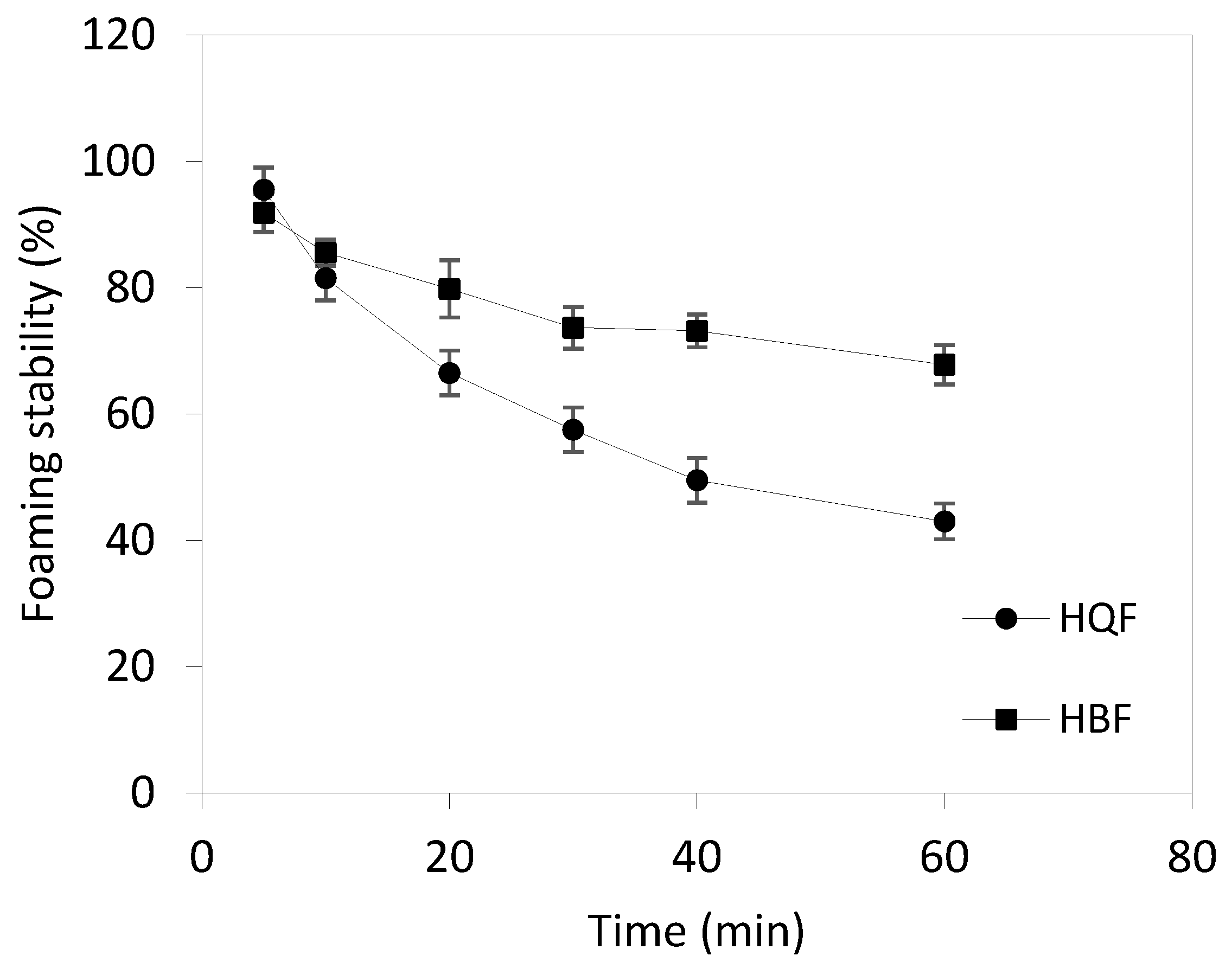Evaluation of Functional and Nutritional Properties of Hydrolyzed Broad Bean and Quinoa Flours †
Abstract
:1. Introduction
2. Materials and Methods
2.1. Materials
2.2. Obtaining Hydrolyzed Flours and Degree of Hydrolysis (DH)
2.3. Performance Parameters and Chemical and Nutritional Properties
2.4. Functional Properties of Hydrolyzed Flours
2.5. Statistical Analysis
3. Results and Discussion
3.1. Degree of Hydrolysis (DH)
3.2. Performance Parameters and Nutritional Composition
3.3. Functional Properties
4. Conclusions
Author Contributions
Funding
Institutional Review Board Statement
Informed Consent Statement
Data Availability Statement
Acknowledgments
Conflicts of Interest
References
- de Antuñano, N.P.G.; Marqueta, P.M.; Redondo, R.B.; Fernández, C.J.C.; de Teresa Galván, C.; del Valle Soto, M.; Bonafonte, L.F.; Gabarra, A.G.; Gaztañaga, T.A.; Manonelles, P.M.; et al. Suplementos nutricionales para el deportista. Ayudas ergogénicas en el deporte-2019. Documento de consenso de la Sociedad Española de Medicina del Deporte. Arch. Med. Deporte 2019, 36, 1–114. [Google Scholar]
- Muhamyankaka, V.; Shoemaker, C.F.; Nalwoga, M.; Zhang, X.M. Physicochemical properties of hydrolysates from enzy-matic hydrolysis of pumpkin (Cucurbita moschata) protein meal. Int. Food Res. J. 2013, 20, 2227–2240. [Google Scholar]
- Lee, J.-Y.; Lee, H.D.; Lee, C.-H. Characterization of hydrolysates produced by mild-acid treatment and enzymatic hydrolysis of defatted soybean flour. Food Res. Int. 2001, 34, 217–222. [Google Scholar] [CrossRef]
- Noman, A.; Qixing, J.; Xu, Y.; Ali, A.; Al-Bukhaiti, W.Q.; Abed, S.M.; Xia, W. Influence of Degree of Hydrolysis on Chemical Composition, Functional Properties, and Antioxidant Activities of Chinese Sturgeon (Acipenser sinensis) Hydrolysates Obtained by Using Alcalase 2.4 L. J. Aquat. Food Prod. Technol. 2019, 28, 583–597. [Google Scholar] [CrossRef]
- Dubois, M.; Gilles, K.A.; Hamilton, J.K.; Rebers, P.A.; Smith, F. Colorimetric Method for Determination of Sugars and Related Substances. Anal. Chem. 1956, 28, 350–356. [Google Scholar] [CrossRef]
- Mota, C.; Santos, M.; Mauro, R.; Samman, N.; Matos, A.S.; Torres, D.; Castanheira, I. Protein content and amino acids profile of pseudocereals. Food Chem. 2014, 193, 55–61. [Google Scholar] [CrossRef] [PubMed]
- Gremasqui, I.A.; Giménez, M.A.; Lobo, M.O.; Sammán, N.C. Nutritional and Functional characterisation of hydrolysates from quinoa flour (Chenopodium quinoa) using two proteases. Int. J. Food Sci. Technol. 2021, 56, 6507–6514. [Google Scholar] [CrossRef]
- Barać, M.; Čabrilo, S.; Pešić, M.; Stanojević, S.; Pavlićević, M.; Maćej, O.; Ristić, N. Functional Properties of Pea (Pisum sativum, L.) Protein Isolates Modified with Chymosin. Int. J. Mol. Sci. 2011, 12, 8372–8387. [Google Scholar] [CrossRef] [Green Version]
- Thamnarathip, P.; Jangchud, K.; Jangchud, A.; Nitisinprasert, S.; Tadakittisarn, S.; Vardhanabhuti, B. Extraction and characterisation of Riceberry bran protein hydrolysate using enzymatic hydrolysis. Int. J. Food Sci. Technol. 2015, 51, 194–202. [Google Scholar] [CrossRef]
- Xia, R. Study on the Reasonable Supplement of Vitamin and Minerals for Athletes. Adv. J. Food Sci. Technol. 2015, 8, 303–305. [Google Scholar] [CrossRef]
- Laohakunjit, N.; Kerdchoechuen, O.; Kaprasob, R.; Matta, F.B. Volatile Flavor, Antioxidant Activity and Physicochemical Properties of Enzymatic Defatted Sesame Hydrolysate. J. Food Process. Preserv. 2016, 41, e13075. [Google Scholar] [CrossRef]
- Betancur-Ancona, D.; Martínez-Rosado, R.; Corona-Cruz, A.; Castellanos-Ruelas, A.; Jaramillo-Flores, M.E.; Chel-Guerrero, L. Functional properties of hydrolysates fromPhaseolus lunatusseeds. Int. J. Food Sci. Technol. 2008, 44, 128–137. [Google Scholar] [CrossRef]


| Parameters # | HBF | HQF |
|---|---|---|
| DH | 12.57 ± 0.96 a | 21.79 ± 0.78 b |
| Mass yield | 32.80 ± 0.93 b | 21.03 ± 1.22 a |
| Protein recovery | 71.32 ± 2.03 b | 67.28 ± 1.73 a |
| Protein content | 57.31 ± 0.27 b | 54.69 ± 0.12 a |
| Lipids content | 0.004 ± 0.000 a | 0.003 ± 0.000 a |
| Ash content | 11.79 ± 0.24 a | 14.11 ± 0.28 b |
| SDF | 10.56 ± 0.41 a | 23.18 ± 0.74 b |
| HC dig. | 20.34 | 8.02 |
| Soluble sugars | 9.95 ± 0.87 a | 9.35 ± 0.89 a |
| Na * | 2376.35 ± 39.60 a | 3121.96 ± 11.65 b |
| Cu * | 2.18 ± 1.04 a | 2.18 ± 0.18 a |
| Fe * | 18.04 ± 3.44 a | 20.25 ± 0.44 b |
| Zn * | 9.26 ± 4.08 b | 7.45 ± 0.57 a |
| Ca * | 411.79 ± 5.66 b | 130.46 ± 1.60 a |
| Mg * | 344.27 ± 1.99 b | 180.27 ± 7.58 a |
| K * | 3526.42 ± 195.20 a | 4000.27 ± 135.70 b |
| Amino Acid (mg/100 g Sample) | HBF a | HQF a | HBF b | HQF b |
|---|---|---|---|---|
| Essential amino acid | ||||
| Histidine | 855.3 ± 25.0 b | 639.3 ± 8.2 a | 26.54 ± 1.53 a | 116.63 ± 2.12 b |
| Threonine | 1375.5 ± 35.9 b | 760.2 ± 3.9 a | 13.54 ± 4.35 a | 27.56 ± 2.95 b |
| Valine | 1578.6 ± 20.4 b | 837.5 ± 1.1 a | 20.04 ± 4.57 a | 41.69 ± 4.77 b |
| Methionine | 292.1 ± 12.5 a | 434.7 ± 5.3 b | 24.91 ± 3.32 a | 50.46 ± 4.02 b |
| Lysine | 1928.8 ± 6.7 b | 1024.6 ± 10.3 a | n.d | n.d |
| Isoleucine | 1344.9 ± 35.5 b | 642.1 ± 0.2 a | 15.95 ± 0.44 a | 35.78 ± 7.07 b |
| Leucine | 2986.1 ± 78.8 b | 1229.3 ± 1.3 a | 27.19 ± 4.06 a | 99.48 ± 4.84 b |
| Phenylalanine | 1540.4 ± 63.0 b | 847.4 ± 1.9 a | 49.48 ± 10.81 a | 149.82 ± 2.60 b |
| Tryptophan | n.d | n.d | 33.31 ± 2.12 a | 91.36 ± 5.13 b |
| Nonessential amino acid | ||||
| Aspartic acid | 6030.4 ± 63.4 b | 2384.3 ± 33.1 a | 206.48 ± 2.17 b | 17.23 ± 2.83 a |
| Glutamic acid | 9475.7 ± 113.9 b | 5475.6 ± 36.2 a | 69.26 ± 4.72 a | 87.68 ± 7.30 b |
| Serine | 2129.2 ± 57.0 b | 1023.0 ± 4.8 a | 11.83 ± 1.21 a | 17.47 ± 2.83 b |
| Arginine | 3409.2 ± 115.0 b | 1624.3 ± 15.5 a | 429.52 ± 7.07 b | 41.50 ± 0.70 a |
| Cysteine | 173.2 ± 21.3 a | 179.4 ± 8.3 b | n.d | n.d |
| Tyrosine | 1338.0 ± 49.5 b | 772.5 ± 9.7 a | 40.77 ± 0.89 a | 95.75 ± 1.55 b |
| Glycine | 1699.5 ± 58.4 b | 1275.5 ± 23.5 a | 22.65 ± 3.62 a | 35.80 ± 0.69 b |
| Alanine | 1921.6 ± 23.4 b | 1139.5 ± 7.5 a | 46.81 ± 1.12 a | 118.95 ± 3.07 b |
| Proline | 1917.7 ± 39.7 b | 919.2 ± 6.9 a | 66.29 ± 4.01 a | 75.31 ± 3.06 b |
| Total amino acid | 39996.2 ± 794.5 b | 21208.5 ± 85.5 a | 1104.56 ± 17.46 b | 1102.48 ± 8.98 a |
| Taste component c | ||||
| Umami | 275.74 ± 6.89 b | 104.92 ± 10.13 a | ||
| Sweet | 501.69 ± 2.63 b | 205.48 ± 2.25 a | ||
| Bitter | 253.05 ± 3.21 a | 604.97 ± 3.29 b |
| Functional Properties | HBF # | HQF # |
|---|---|---|
| EAI (m2/g) | 38.57 ± 1.45 a | 61.30 ± 0.14 b |
| ESI (min) | 55.01 ± 3.56 a | 158.60 ± 1.70 b |
| FC (%) | 89.50 ± 6.36 a | 131.00 ± 4.24 b |
Publisher’s Note: MDPI stays neutral with regard to jurisdictional claims in published maps and institutional affiliations. |
© 2022 by the authors. Licensee MDPI, Basel, Switzerland. This article is an open access article distributed under the terms and conditions of the Creative Commons Attribution (CC BY) license (https://creativecommons.org/licenses/by/4.0/).
Share and Cite
Gremasqui, I.d.l.A.; Giménez, M.A.; Lobo, M.O.; Sammán, N.C. Evaluation of Functional and Nutritional Properties of Hydrolyzed Broad Bean and Quinoa Flours. Biol. Life Sci. Forum 2021, 8, 12. https://doi.org/10.3390/blsf2021008012
Gremasqui IdlA, Giménez MA, Lobo MO, Sammán NC. Evaluation of Functional and Nutritional Properties of Hydrolyzed Broad Bean and Quinoa Flours. Biology and Life Sciences Forum. 2021; 8(1):12. https://doi.org/10.3390/blsf2021008012
Chicago/Turabian StyleGremasqui, Ileana de los A., Maria A. Giménez, Manuel O. Lobo, and Norma C. Sammán. 2021. "Evaluation of Functional and Nutritional Properties of Hydrolyzed Broad Bean and Quinoa Flours" Biology and Life Sciences Forum 8, no. 1: 12. https://doi.org/10.3390/blsf2021008012
APA StyleGremasqui, I. d. l. A., Giménez, M. A., Lobo, M. O., & Sammán, N. C. (2021). Evaluation of Functional and Nutritional Properties of Hydrolyzed Broad Bean and Quinoa Flours. Biology and Life Sciences Forum, 8(1), 12. https://doi.org/10.3390/blsf2021008012






